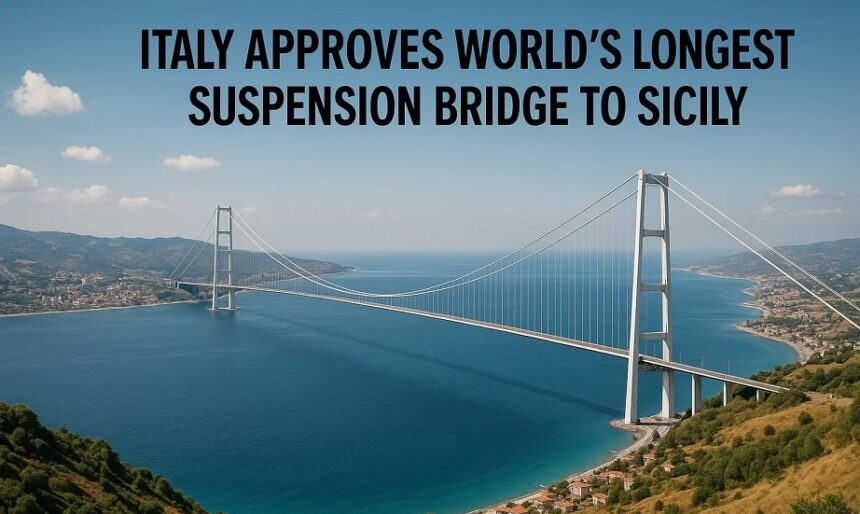On August 6, 2025, Italy’s government granted final approval for a €13.5 billion ($15.6 billion) project to construct the world’s longest suspension bridge, spanning the Strait of Messina to connect Sicily with mainland Italy. The 3.67-kilometer (2.3-mile) bridge, with a record-breaking 3.3-kilometer suspended span, is designed to withstand earthquakes up to 7.5 magnitude and winds of 180 mph. Championed by Prime Minister Giorgia Meloni and Transport Minister Matteo Salvini, the project promises to boost economic development in Sicily and Calabria, creating over 100,000 jobs. However, critics warn of environmental damage, potential mafia infiltration, and financial risks, with the Italian Court of Auditors questioning the debt-laden state’s investment. The approval by the Interministerial Committee for Economic Planning and Sustainable Development (CIPESS) marks a significant milestone for a project debated since the 1960s.
Background of the Messina Strait Bridge
The idea of linking Sicily to mainland Italy dates back to Roman times, when Consul Metellus reportedly used barrels and wood to transport war elephants across the Strait in 252 BCE. Modern plans emerged in the 1960s, with €1.2 billion spent on feasibility studies since 1965. The project has faced multiple cancellations, notably in 2006 under Romano Prodi and 2013 during the eurozone debt crisis, despite a 2006 tender awarded to Eurolink, led by Italian contractor Webuild. Revived by Meloni’s right-wing government in 2023, the bridge is now a priority to address southern Italy’s economic stagnation, where unemployment in Sicily and Calabria exceeds 15%, compared to 7% nationally.
The bridge will connect Torre Faro in Sicily to Villa San Giovanni in Calabria, spanning a 3.2-kilometer waterway with strong currents and seismic risks due to the Messina fault, which caused a 7.1-magnitude earthquake in 1908, killing over 100,000. The current design, based on a 2011 plan with updates, features two 399-meter towers, two railway lines, and three traffic lanes per direction, accommodating 6,000 vehicles per hour and 200 trains daily. It will provide a 600-meter navigation channel and 74-meter clearance for large vessels.
Key Project Details | Information |
|---|---|
Total Length | 3.67 km (2.3 miles) |
Suspended Span | 3.3 km (2.05 miles, world record) |
Tower Height | 399 meters (1,309 feet) |
Cost | €13.5 billion ($15.6 billion) |
Completion Date | 2032 |
Capacity | 6,000 vehicles/hour, 200 trains/day |
Contractor | Webuild-led Eurolink consortium |
Economic and Strategic Rationale
The bridge is pitched as a “development accelerator” for Sicily and Calabria, regions with high poverty and unemployment. Salvini projects it will contribute €2.9 billion to GDP during construction, create 100,000 jobs, and enhance trade by allowing direct rail and road transport from Suez Canal ports to northern Europe, bypassing lengthy sea routes. The bridge is part of the Berlin-Palermo railway axis in the Trans-European Transport Networks (TEN-T), cutting train travel time from two hours to 10 minutes.
Italy also seeks to classify the bridge as “defense-related” infrastructure to meet NATO’s 5% GDP spending target, driven by U.S. President Donald Trump’s demands. With Sicily hosting a NATO base, Rome argues the bridge supports rapid troop and equipment deployment to NATO’s southern flank. The EU has provided €25 million for design costs, covering 50% of the executive design phase, but critics, including over 600 academics, argue the military classification is a stretch and could make the bridge a target.
Engineering and Environmental Challenges
Designed by Webuild, which built the Canakkale Bridge (2,023 meters), the Messina Strait Bridge uses a wing-like deck to reduce wind resistance and is engineered to withstand 7.5-magnitude earthquakes. Geologist Giovanni Barreca notes the fault line separating Sicily and Calabria moves 3.5 mm annually, but the bridge’s pylons on one side mitigate seismic risks. Webuild’s CEO, Pietro Salini, claims the project leverages “millions of pages” of studies to address the strait’s dynamic currents and depths (up to 200 meters).
Environmental concerns are significant. The World Wildlife Fund and local groups warn of disruptions to bird migration routes and marine ecosystems. The project’s €13.5 billion cost, criticized by the Italian Court of Auditors, has sparked protests, with MP Nicola Fratoianni calling it a “financial black hole” that diverts resources from healthcare and education. The centre-left Democratic Party argues it violates environmental and safety norms.
Mafia and Corruption Risks
Southern Italy’s history of organized crime, particularly the Sicilian Cosa Nostra and Calabrian ‘Ndrangheta, raises fears of mafia infiltration. The Messina public prosecutor warned of potential exploitation, despite the 2023 arrest of Cosa Nostra boss Matteo Messina Denaro, who opposed the bridge. Salvini insists supervisory bodies will monitor every euro, and Webuild’s global partners, including Japan’s IHI and Denmark’s COWI, aim to ensure transparency. However, past infrastructure projects, like the collapsed Morandi Bridge, highlight Italy’s vulnerability to corruption.
Historical Context and Political Significance
The bridge has been a political lightning rod for decades. Revived under Silvio Berlusconi in the 2000s, it was canceled by Mario Monti in 2013 due to austerity measures. Meloni’s government, elected in 2022, sees it as a symbol of Italy’s engineering prowess and a tool to unify the nation’s north and south. Salvini calls it a “revolution” for southern Italy, while Meloni frames it as a “demonstration of Italy’s willpower and technical expertise.” Critics, citing Italy’s history of abandoned projects, remain skeptical, with a popular saying—“I’ll do it when the Messina bridge is finished”—reflecting doubts about its completion.
Current Developments and Timeline
The CIPESS approval allows preliminary work, including archaeological and geological surveys, to start in late 2025, with full construction expected in 2026. The national audit court’s validation, expected within weeks, is the final hurdle. Webuild, which secured the contract in 2006 and retained it for the revival, will lead construction, supported by firms like Japan’s IHI, involved in the Akashi and Osman Gazi bridges. The project’s €13.5 billion budget includes road and rail links, with completion targeted for 2032.
Implications and Criticisms
The bridge promises to transform Sicily’s economy, easing ferry congestion and boosting trade. However, its €13.5 billion cost, equivalent to 6% of Italy’s 2024 budget, has drawn scrutiny, especially as Italy’s debt-to-GDP ratio exceeds 140%. The Italian Court of Auditors warned of financial strain, while the Democratic Party claims it “tramples common sense.” Environmentalists fear ecosystem damage, and over 600 academics oppose its NATO classification, citing risks of militarization. Posts on X reflect mixed sentiment, with some praising the engineering ambition and others decrying the cost and mafia risks.
What’s Next
As preliminary work begins, Italy will seek to secure EU funding beyond the €25 million design grant and justify the bridge’s NATO classification. Environmental protests and legal challenges may delay progress, while oversight to prevent mafia infiltration will be critical. If completed, the bridge could redefine southern Italy’s economic landscape, but its success hinges on overcoming seismic, environmental, and financial challenges in a region with a complex history of infrastructure failures.
Conclusion
The approval of the Strait of Messina Bridge marks a historic step toward connecting Sicily to mainland Italy, fulfilling a 2,000-year-old dream. With a record-breaking 3.3-kilometer span, the €13.5 billion project showcases Italy’s engineering ambition but faces significant hurdles, including environmental concerns, mafia risks, and financial scrutiny. As construction gears up for 2026, the bridge’s fate will test Italy’s ability to balance economic goals with transparency and sustainability, under global scrutiny driven by its NATO and EU ties.












